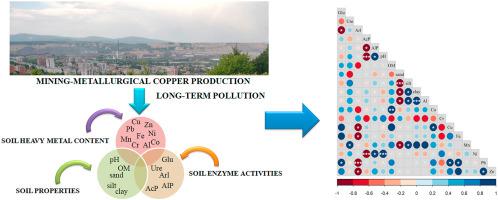当前位置:
X-MOL 学术
›
Eur. J. Soil Biol.
›
论文详情
Our official English website, www.x-mol.net, welcomes your
feedback! (Note: you will need to create a separate account there.)
Soil enzyme activities under the impact of long-term pollution from mining-metallurgical copper production
European Journal of Soil Biology ( IF 3.7 ) Pub Date : 2020-11-01 , DOI: 10.1016/j.ejsobi.2020.103232 Jelena S. Milosavljevic , Snezana M. Serbula , Djuro M. Cokesa , Dragan B. Milanovic , Ana A. Radojevic , Tanja S. Kalinovic , Jelena V. Kalinovic
European Journal of Soil Biology ( IF 3.7 ) Pub Date : 2020-11-01 , DOI: 10.1016/j.ejsobi.2020.103232 Jelena S. Milosavljevic , Snezana M. Serbula , Djuro M. Cokesa , Dragan B. Milanovic , Ana A. Radojevic , Tanja S. Kalinovic , Jelena V. Kalinovic

|
Abstract This study aimed to evaluate the activities of five soil hydrolases (β-glucosidase, urease, arylsulphatase, acid and alkaline phosphatase) as indicators in the area characterized with long-term pollution from one of the biggest copper smelters in Southeastern Europe. Sampling of the root zone soil of Plantago spp. was performed at five sites, at different distances from the copper smelter as the main pollution source. The results revealed serious heavy metal pollution of soil, whereby Cu, Pb and Zn were described as the primary pollutants. Concentrations of Cu, Pb and Zn were about 100, 5, and 4 times higher, respectively, than the corresponding limit values defined by the Serbian Regulation at the extremely polluted site in the proximity to the copper smelter. Among the five studied soil hydrolase activities, arylsulphatase was found to be the most sensitive to the soil heavy metal content, being significantly negatively correlated with Cu, Fe, Pb and Zn. Enzyme activity change ratio indicated inhibition of arysulphatase activity in the contaminated soils. The results denoted that arysulphatase activity could be regarded as an indicator of the soil contamination by heavy metals. The observed effects of the heavy metal concentrations on the soil enzyme activities pointed out the potential alterations of soil nutrient cycles, as well as soil quality degradation.
中文翻译:

矿冶铜生产长期污染影响下的土壤酶活性
摘要 本研究旨在评估五种土壤水解酶(β-葡萄糖苷酶、脲酶、芳基硫酸酶、酸性和碱性磷酸酶)的活性,作为东南欧最大铜冶炼厂之一长期污染地区的指标。车前草根区土壤的取样。在距离主要污染源铜冶炼厂不同距离的五个地点进行。结果表明土壤重金属污染严重,其中Cu、Pb和Zn为主要污染物。Cu、Pb 和 Zn 的浓度分别比塞尔维亚法规在铜冶炼厂附近污染严重的地点规定的相应限值高约 100、5 和 4 倍。在研究的五种土壤水解酶活性中,芳基硫酸酯酶对土壤重金属含量最为敏感,与Cu、Fe、Pb、Zn呈显着负相关。酶活性变化率表明受污染土壤中芳基硫酸酯酶活性受到抑制。结果表明芳基硫酸酯酶活性可作为土壤重金属污染的一个指标。观察到的重金属浓度对土壤酶活性的影响指出了土壤养分循环的潜在改变,以及土壤质量退化。结果表明芳基硫酸酯酶活性可作为土壤重金属污染的一个指标。观察到的重金属浓度对土壤酶活性的影响指出了土壤养分循环的潜在改变,以及土壤质量退化。结果表明芳基硫酸酯酶活性可作为土壤重金属污染的一个指标。观察到的重金属浓度对土壤酶活性的影响指出了土壤养分循环的潜在改变,以及土壤质量退化。
更新日期:2020-11-01
中文翻译:

矿冶铜生产长期污染影响下的土壤酶活性
摘要 本研究旨在评估五种土壤水解酶(β-葡萄糖苷酶、脲酶、芳基硫酸酶、酸性和碱性磷酸酶)的活性,作为东南欧最大铜冶炼厂之一长期污染地区的指标。车前草根区土壤的取样。在距离主要污染源铜冶炼厂不同距离的五个地点进行。结果表明土壤重金属污染严重,其中Cu、Pb和Zn为主要污染物。Cu、Pb 和 Zn 的浓度分别比塞尔维亚法规在铜冶炼厂附近污染严重的地点规定的相应限值高约 100、5 和 4 倍。在研究的五种土壤水解酶活性中,芳基硫酸酯酶对土壤重金属含量最为敏感,与Cu、Fe、Pb、Zn呈显着负相关。酶活性变化率表明受污染土壤中芳基硫酸酯酶活性受到抑制。结果表明芳基硫酸酯酶活性可作为土壤重金属污染的一个指标。观察到的重金属浓度对土壤酶活性的影响指出了土壤养分循环的潜在改变,以及土壤质量退化。结果表明芳基硫酸酯酶活性可作为土壤重金属污染的一个指标。观察到的重金属浓度对土壤酶活性的影响指出了土壤养分循环的潜在改变,以及土壤质量退化。结果表明芳基硫酸酯酶活性可作为土壤重金属污染的一个指标。观察到的重金属浓度对土壤酶活性的影响指出了土壤养分循环的潜在改变,以及土壤质量退化。











































 京公网安备 11010802027423号
京公网安备 11010802027423号